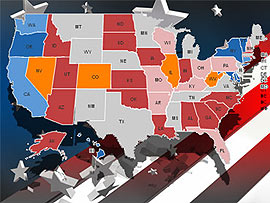CBS News' 2010 National House Model: What Does the National House Vote Mean?
Before an election, the "generic" national House preference is often used to indicate how the battle for Congress is going. We see this reported in national polls all the time.
But the House isn't decided by a national vote, of course - it's 435 separate elections - and that generic vote number leaves us wondering what it specifically means for seats won or lost. So how can we translate the national House vote into prospects for House control?
This CBS News 2010 National House Model offers some guidance.
It is a mathematical simulation of how possible national vote outcomes could affect all 435 seats -- based on a CBS News Election team analysis of historical voting patterns, the past and present characteristics of 435 districts, and the current competitiveness level of all districts in 2010.
Note that this is not a poll.... nor is it a prediction; it's a guide to understanding what the national numbers you see might really mean in today's context. Importantly, this is a national model that cannot say which individual districts will flip or not - and it isn't designed to do that. It's about how many. Nor are we predicting any outcomes for a party at this point. We'll have to wait for election night for that, when the real votes are counted.
A complete description follows, but first, the results:
- As of today, a national two-party vote of 52 percent or more Republican indicates the GOP would probably win enough seats to take control of the House on Election Day.
- But in this environment with so many competitive and tossup districts, very small changes in national vote are equated with meaningful shifts in the possibilities for House control.
With 52 percent of the two-party national vote, the model shows that Republicans could end up with 226 seats (they need 218 for a majority) and most likely get something in the range of 215 and 237 seats.
Think of that range as a bit like a margin of error -- and yes, it is a wide range, but that's a reflection of the large number of tossups still out there, which the model necessarily takes into account. If Republicans get that 52 percent, the number of Democratic seats would drop into a range between 198 and 220 seats, with the most likely specific outcome being 209 seats, and loss of control.
- A 51 percent national vote would mean House control is a razor-close tossup. If you see that in the polls right before Election Day, expect a tight race for control as the votes are counted. Republicans still make gains, and would expect to draw about even with the Democrats at around 218, but the ranges of the estimate are wide enough that either party could end up with narrow control in that kind of a tight national vote scenario.
- If Democrats keep the national two-party vote even, that would be a sign that they could keep control, though the GOP would pick up seats. In a dead-even national vote scenario, the Republicans would make gains and eat away at the Democrats' sizeable current majority, but get to 210 seats while the Democrats would retain 225.
How the Model Works
Movement in the national vote is often described as a wave that picks up more and more districts in its wake the bigger and bigger it gets. That's not a bad metaphor - but we need to translate it into numbers.
First, we start with what we know about the national house vote: it is really made up of the aggregate Democratic and Republican totals from 435 distinct contests. We also know that individual districts won't all move perfectly in concert with the national vote in a Democratic or Republican direction; some will be more sensitive than others to any national movements we see.
You can picture this if you consider that some districts will inevitably have more independents or swing voters than others. Or that local contests will insulate many districts from national trends: for instance, think of all the House districts (and there are many) where long-time incumbents reliably collect the same percent of the vote every year and are on pace to do so again. Now think about those compared to districts where there are wide-open races with voters vacillating between candidates. You'd imagine the latter type could be responsible for relatively more of the total national movement that we see.So with that in mind, we build a model that takes into account a variety of characteristics in each and every House district that could (and do) impact the Democratic and Republican vote shares, including whether it is an open or incumbent-held seat; its past vote history in this decade; the level of competition it saw in all of those years; what kind of national election (midterm or presidential) it was; demographic data for the district; the increases or decreases in turnout year to year, among other factors.
To understand how sensitive every type of district is to the national vote, we analyzed exactly how those types of districts varied in their own district-level vote compared to the aggregate national vote every year. In doing that comparison, we controlled for each of those district-level characteristics, so that we could isolate their impact.
Next, though, we have to remember that it's not just about movement in vote - it's ultimately about winners and losers in every district. A party falls over the 50 percent line and wins, or under, and loses. So we need to know whether variations in vote will make a district flip parties, and that depends not just on size of the movement but on how close each of the contests is in every district. A district whose voting routinely hovers around 50 percent for each party doesn't take much of swing to tilt it one way or the other; it only takes a little swing to flip a 51-49 Democratic district, for instance, to a 51-49 Republican win. But in a district, say, where a Democrat routinely wins around 70 percent of the vote, even a big 10 percent swing toward the GOP won't matter in who wins and loses; the Democrat would still win with 60 percent.
So when we know the degree to which vote changes in any particular district (based on all it's characteristics) is associated with changes in the national vote, and we know how closely contested the partisan divide is in all the districts, we can put the two together and simulate how many would "flip" parties as the national vote share - the assemblage of all those districts results - swings to and fro.
For 2010, in addition to the past profiles, we know and include in the simulation the level of competitiveness of all 435 districts in 2010 from the CBS News Critical Contests lists, some of which are edging Republican, some edging Democrat, and some are pure tossups.
This is about understanding how swings in the national vote could affect the number of seats that turnover and swing control of Congress, and is, hopefully, a useful guide to interpreting what all that movement in the national generic numbers could ultimately mean. When you see a national generic used as an indicator of the House, you'll know, with a little more specificity, what it indicates.
As more individual districts change in their ratings of competitiveness, we'll update the model again.
Analysis by Anthony Salvanto and Tiffany Washburn.



